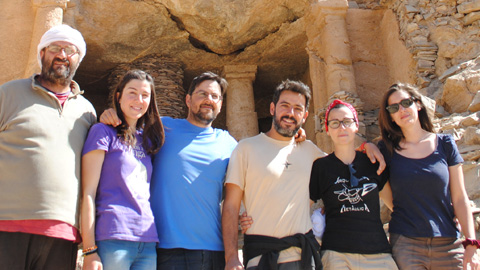Roman Empire’s only emerald mines could have been privately owned

12/06/2019
The Sikait archaeological site at the mountain Mons Smaragdus (Eastern Desert, Egypt) contains the only emerald mines belonging to the Roman Empire. A team of researchers led by Professor Joan Oller from the Department of Antiquity and Middle Age Studies at the UAB has identified an entrance to the site’s mines in a construction which suggests the mineral strip mines were privately owned.
The site containing the emerald, a green variety of the beryl mineral, was probably linked to the city of Berenice, founded by Ptolemy II Philadelphus in the 3rd century BCE, and occupied by the Romans from the 1st to 6th century CE. It is located in a dry valley (Wadi) of a mountainous region with dwellings on the dry riverbed and constructions on the valley slopes which until now had also been identified as dwellings. These buildings are very well and almost entirely conserved, with walls reaching up to four metres in height.
With the data collected throughout the 2018 campaign, now published in the journal Nilus, UAB researchers verified that the buildings found on the valley slopes were most probably entrances to a series of privately owned mines. Thanks to the study of one of these buildings, identified as the Six Windows Building, researchers concluded that it was a productive complex linked to the extraction and handling of emeralds, with resting areas, changing rooms and a provisions area in which they found coins, a clay bowl filled with dried fruit, and also military elements possibly belonging to soldiers guarding the entrances.
The key element has been the discovery on the wall built into the rock of what seemed to be a wardrobe or niche which, when excavated, turned out to be the opening to a gallery. About half a metre later, the gallery transformed into a small vertical well through which the mineral strips could be accessed. The discovery of an abundance of beryl fragments and remains in the room confirmed this hypothesis.
“The fact that no texts have been found in this region multiplies the importance of having made these discoveries, since they offer a lot of information about life in that period”, researcher coordinator Joan Oller states. In fact, “the economic model inferred is different to what is expected in this area, since these protected mines could have been privately owned, whereas the empire had many publicly owned mines and quarries”. The fact that these are enclosed areas and a possible presence of soldiers “would indicate that it was not an open mine extraction, but rather that there were private mining concessions where families or communities could extract the mineral from a specific strip. If this hypothesis could be confirmed it would radically change the views of this site, given that the structures located on the rocky mountain slopes could be linked to the mining of beryl and not to the residential areas, which are concentrated at the bottom of the valley”, Oller explains.
The archaeological complex includes some 150 to 200 documented structures. In their study, researchers also observed that one of the site’s dwellings, which seemed to have been used for administrative purposes, was in reality a temple. This imposing building is located on a terrace at the entrance to the settlement. “Its structure, preeminent position and the materials recovered reveal a clearly ritual purpose, such as statuettes, burners, glass mosaics, coins and a plaque with possibly Coptic icons,” make Professor Joan Oller believe that “in reality we are not looking at an administrative building, but more probably a temple”.
The archeaological Sikait Project works in the Eastern Desert in Egypt. It conducted its first archaeological dig in 2018 thanks to funding received from the Fundación Palarq and a second dig was conducted in the month of January 2019. The archaeologists’ main interest is the area of the Wadi El Gemal National Park, where the only archaeological sites from Roman times dedicated to the extraction of emeralds are located. The digs are conducted with the involvement of the universities of Delaware, USA, and Warsaw, Poland, and with the support of the Egyptian Ministry for Antiquities.
Photo of the researchers of the Sikait Project at the archaeological site. From left to right: Oriol Achon Casas, Vane Trevín Pita, David Fernández Abella, Joan Oller Guzmán, Adriana Molina Pérez and Delia Eguiluz Maestro.
Original article:
J. Oller. "L'explotació de maragdes a l'Egipte romà". Nilus, 27 (2018), 13-19.